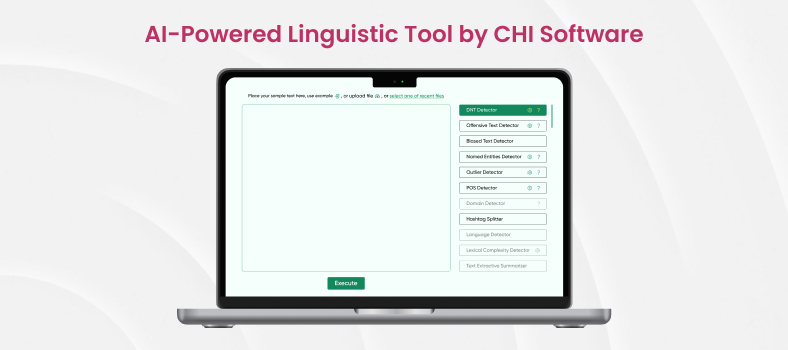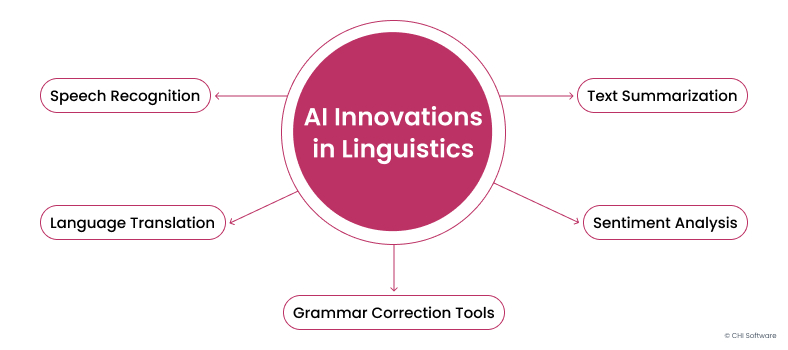Out of all the inventions produced by humans over thousands of years, language holds a very special place. It is the most important discovery we have made, and we constantly improve and study it. Language is so important in our lives that it feels like something natural, something that always existed.
Humans continuously improve on this fundament and iterate on it. With the first computers, we got Language Technology (LT). It studied methods of how computer programs analyze, produce, respond, and modify human text and speech. In the 90s, LT evolved into natural language processing (NLP).
Today, NLP advancements are used everywhere – chatbots, autocorrect tools, text-to-speech, and speech-to-text technologies – the list goes on. But how exactly does it improve existing technologies? Let’s look at a couple of examples of AI in language processing.
CHI Software Experience: AI-Enhanced Linguistic Tool
Like any other business, linguistic companies are in constant search of improvements to provide their customers with the best services they can. The same applies to our client from America, which was looking to improve efficiency, enhance data extraction and data security, and create custom APIs for specific user needs.
Our Solution
The tool we developed came in three distinct solutions: an intelligent question-answering system, universal smart scraping, and migration to LLaMa-2 for strengthened data security. Let’s cover them one by one.
Question-Answering System
We created a Q&A chatbot to provide customer support. It comes with additional features:
- Document indexer that can filter vast amounts of documents;
- Customized prompts that allow users to specify the number of documents they want to check for relevant information.
Beyond Conversations: Exploring ChatGPT Capabilities in Business
Read more
Universal Smart Scraping
This system is used to extract important web content. To build it, we used a Large Language Model (LLM) and DOM analysis. As a result, we got a precise system that takes into account the hierarchical structure of web pages.
Migration to LLaMa-2
One of the client’s concerns was about security. To answer this, we migrated their solution to Meta’s LLaMa-2 from GPT-3.5 to GPT-4. This minimized security risks and gave our client an opportunity to create custom APIs.
All of these solutions combined improved efficiency, enhanced data security and gave a competitive edge for our client. Now that we’ve covered all of the project milestones, let’s talk about the key features.

Project Features
Since each solution is a part of a bigger tool, we will cover all features at once. Here they are:
- Continuing input text generation;
- Extracting terminology from mono- and bilingual documents;
- Identifying mismatches in specific metrics;
- Utilizing document indexing systems for filtering;
- Crafting precise queries for Q&A bot responses;
- Managing multiple queries simultaneously;
- Safeguarding sensitive data to enhance autonomy;
- Processing content in multiple languages.
This project is still ongoing, but our client has already noticed the first improvements. For example, a 20% boost in efficiency thanks to automated workflow. Or improved data security after migration.
This project is a great example of how businesses adapt to the ever-changing industry. The world is not standing in one place, and your business shouldn’t. There is a constant need to evolve. You can learn more about this project here.
If you feel the urge to enhance your business, you need an expert team. We at CHI Software can offer our expertise in linguistic AI applications that will improve your business. Contact us today, and get ready for the next step of your business journey.
How AI-Driven Linguistics Analysis Changes Linguistics Technology in the World
Our project is just a glimpse of what natural language understanding with AI can do. There are various ways you can utilize this technology in the linguistics industry.
In our introduction, we have mentioned natural language processing as the innovation that improves linguistic technologies nowadays. Let’s talk about it.
NLP is a branch of AI that helps machines understand different languages. Thanks to the advancements in deep learning, it can detect the meanings, feelings, and context of written or spoken text. It works best when synergized with other AI branches, such as machine learning.
Some examples of NLP and machine learning in linguistic technology include (but are not limited to) the following.

Speech recognition enables communication between humans and machines by translating spoken words into written text. Think of Siri or Alexa as an example. But AI in conversational interfaces doesn’t stop there. It can also be used as a security measure or a form of hearing aid when transcribing videos.
Language translation allows users to translate text or web pages. But it doesn’t stop there. You can take a picture of some text and translate it to the language of your choosing by using an app and a smartphone camera. Or how about real-time translation of a conversation between two people speaking different languages? Easy! It was already done for the first time a year ago.
AI Writes Back: Exploring the Benefits of Large Language Models for Your Business
Read more
Grammar correction tools: Every now and then, everybody leaves a typo in their email or message. If only there were a tool that underlined misspelled words and suggested a correct way of spelling them… Oh wait, that already exists. But with the power of AI, users can do much more. How about reading through sentences and coming up with better phrasing? Or rewriting whole paragraphs to sound more coherent and impactful? That’s what AI brings to the table.
Text summarization: Imagine you need to read through hundreds of documents in one sitting. Sounds exhausting, right? AI can detect key information and generate a summary of the key points.
Sentiment analysis can detect emotions in text and mark them as positive, negative, or neutral. Thanks to the advancements of AI for language understanding, you’ll know whether your customer is happy with you or not.
As we said, this isn’t the full list of things that AI brings to linguistics technologies. However, you can clearly see the value and impact of advanced algorithms. From text analysis with AI to speech recognition technologies, innovations can help you deal with everything!
Final thoughts
Languages and speech are two of the greatest things humanity ever invented. And with recent developments in AI-driven linguistic analysis, we can push language understanding even further.
The potential is limitless – from speaking with people from other countries without the need for a common language to translating texts on artifacts from the past.
We at CHI Software are eager to show you what the power of AI can bring to your linguistics technology business – contact us today and get an expert-level team to make your goals become a reality!
FAQs
-
What is the role of AI in transforming linguistic technology?

Thanks to the ability to quickly adapt and analyze large amounts of data, AI brings efficiency and high adaptability to businesses.
AI is already used in the linguistic industry by some organizations. Some of the use cases we saw are speech recognition, language translation, text summarization, and sentiment analysis.
-
How does natural language processing (NLP) contribute to advancements in linguistic technology?

Some of the use cases include speech recognition and sentiment analysis. With speech recognition, the user can talk to a machine, and the AI will listen, detect words the user says, and then respond accordingly.
When it comes to sentiment analysis, NLP can detect the mood behind a message by looking at the specific wording and then deciding if it's positive or negative.
-
How to use machine learning in linguistic analysis and text processing?

ML models are a perfect solution when you have tasks that require analyzing large amounts of data. This is a problem that both linguistics analysis and text processing deal with.
Most of the common uses of ML in the industry come down to text processing. This is a general term that covers language translation, sentiment analysis, and spam filtering solutions.
-
How do generative AI models impact language generation and conversational interfaces?

The strengths of generative AI are its content creation and problem-solving skills, which are perfect for chatbots and virtual assistants. When powered by generative AI, such systems can give relevant and context-sensitive responses to user’s questions. This makes them almost indistinguishable from humans.
-
How can businesses leverage AI innovations in linguistic technology to improve customer experience?

There are two main ways AI can improve customer experience.
The first one is AI-powered customer support and virtual assistants. They can generate context-sensitive answers to users’ questions and are available 24/7.
The second one is personalized recommendations. AI can analyze customers’ behavior and interests. Based on this data, it can provide item recommendations that cater to users’ preferences.
About the author
Olha Kanishcheva
ML/NLP Engineer, Researcher
Olha boasts a decade-long journey in NLP, currently serving as a researcher at Jena University and a Consulting ML/NLP Engineer at CHI Software. Her expertise extends to various realms of NLP, including text summarization, named entity recognition, and keyword extraction. Olha's Ph.D. thesis explored knowledge representations and information retrieval in librarian systems.




